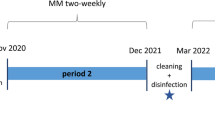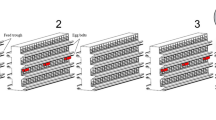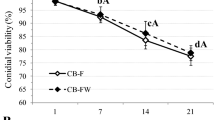Abstract
The objective was to evaluate the epidemiology and population dynamics of a Dermanyssus gallinae infestation during a one-year period, in both amultilevel aviary system and a one-floor plastic slat system. The used layer houses had a history of a D. gallinae problem and were treated during the service period when the chicken houses were empty. In the present study, mites were detected in the monitoring traps for the first time in both sheds 26 and 39 days after restocking. The number of mites steadily increased from the first detection of mites until a first phoxim treatment. The highest numbers of mites were trapped in the supply and resting areas in both housing systems. A 2,000 ppm phoxim spray solution against the D. gallinae infestation was administered twice with a seven-day interval in the two systems on days 227/234 and 278/285. The reduction in the number ofmites after treatment was 99.3% to 90.0% in the aviary system, whereas it was 97% to 94.5% in the plastic slat system. There was no evidence that the growing mite population had any effect on the average daily egg-laying rate or the number of dead hens.
Similar content being viewed by others
References
Arkle S, Guy JH, BlackettM, Sparagano O (2004). Variation in the population of Dermanyssus gallinae in a free-range laying unit and effectiveness of chemical control. Br Poult Sci 45:45–46.
Auger A, Nantel J, Meunier N, Harrison JR (1979). Skin acariasis caused by Dermanyssus gallinae (de Geer) an inhospital outbreak. Can Med Assoc J 17:700–703.
Beck W (1999). Farm animals as disease vectors of parasitic epizoonoses and zoophilic dermatophytes and their importance in dermatology. Der Hautarzt 50:621–628.
Beugnet F, Chauve C, Gauthey M, Beert L (1997). Resistance of the poultry redmite to pyrethroids in France. Vet Rec 140:577–579.
Cencek T (2003). Prevalence of Dermanyssus gallinae in poultry farms in the Silesia region in Poland. Bull Vet Inst in Pulawy (Poland) 47:465–469.
Chauve C (1998). The poultry red mite Dermanyssus gallinae (De Geer, 1778): current situation and future prospects for control. Vet Parasitol 79:239–245.
Chirico J, Tauson R (2002). Traps containing acaricides for the control of Dermanyssus gallinae. Vet Parasitol 110:109–116.
Chirico J, Eriksson H, Fossum O, Janson D (2003). The poultry red mite, Dermanyssus gallinae, a potential vector of Erysipelothrix rhusiopathiae causing erysipelas in hens. Med Vet Entomol 17:232–234.
Eckert J, Friedhoff KT, Zahner H, Deplazes P (2005). Lehrbuch der Parasitologie für die Tiermedizin. Enke Verlag, Stuttgart, pp. 369–371.
Heine J, Meyer-Kühling B, Keita A, Baduel L, Pfister K (2005). Phoxim 50% E.C. (ByeMite®) for treatment of Dermanyssus gallinae in laying hens. Proc. 20th WAAVP, 16–20 October 2005, Christchurch, New Zealand, Abstract p. 273.
Hoffmann G (1987). Vogelmilbe als Lästlinge, Krankheitserzeuger und Vektoren beiMensch und Nutztier. Dt tierärztl Wschr 95:7–10.
Kirkwood AC (1967). Anaemia in poultry infested with the red mite Dermanyssus gallinae. Vet Rec 80:514–516.
Nordenfors H, Chirico J (2001). Evaluation of a sampling trap for Dermanyssus gallinae (Acari: Dermanyssidae). J Econ Entomol 94:1617–1621.
Meyer-Kühling B, Pfister K, Müller-Lindloff J, Heine J (2005). Phoxim 50% E.C. (ByeMite®) zur Behandlung von Dermanyssus gallinae bei Legehennen unter Praxisbedingungen. Proc. Tagung der DVG-Fachgruppe Parasitologie und Parasitäre Krankheiten: Diagnostik, Epidemiologie und Bekämpfung von Parasitosen bei Nutz-, Haus- und Heimtieren, 23–24 June 2005, Potsdam, p. 19.
Nordenfors H, Höglund J, Tauson R, Chirico J (2001). Effect of permethrin impregnated plastic strips on Dermanyssus gallinae in loose-housing systems for laying hens. Vet Parasitol 102:121–131.
Nordenfors H, Hoeglund J (2000). Long-term dynamics of Dermanyssus gallinae in relation to control measures in aviary systems for layers. Br Poult Sci 41:533–540.
Schneider J, Haaß K (1971). Untersuchungen zur Schadwirkung der roten Vogelmilbe (Dermanyssus avium) in Intensivhühnerbeständen. Berl Münch tierärztl Wschr 84:130–132.
Svedberg J (1991). Distribution of mites (Dermanyssus gallinae) in a voletage-system for layers. Proc. Int Congr Animal Hyg, Leipzig, pp. 176–182.
Zeman P, Stika V, Skalka B, Bartik M, Dusbabek F, Lavickova M (1982). Potential role of Dermanyssus gallinae De Geer, 1778 in the circulation of the agent of pullurosis-typhus in hens. Folia Parasitol (Prague) 29:371–374.
Author information
Authors and Affiliations
Corresponding author
Rights and permissions
About this article
Cite this article
Meyer-Kühling, B., Heine, J., Müller-Lindloff, J. et al. Epidemiology of Dermanyssus gallinae and Acaricidal Efficacy of Phoxim 50% in Alternative Housing Systems during the Laying Period of Hens. Parasitol Res 101 (Suppl 1), 1–12 (2007). https://doi.org/10.1007/s00436-007-0605-9
Published:
Issue Date:
DOI: https://doi.org/10.1007/s00436-007-0605-9




